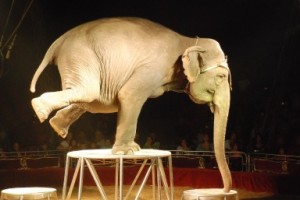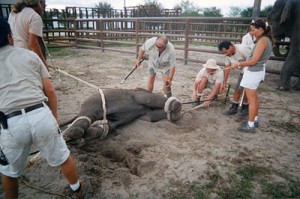The Circus – A Nightmare for Animals

Once again, Albany played host to the annual dreary migration of the Ringling Bros. and Barnum & Bailey circus as it forced its performing animals to entertain the crowds for a three-day engagement in May. Again, the elephants were prodded as they marched from their unloading site to the Times Union arena along downtown streets — a far cry from the migrating marches of the family–based elephant herds in Africa who have the good fortune to live their natural lives in the satisfaction of their physical, psychological, and emotional needs.All circus animals endure lives that are stressful and often cruel, depending on the species. The domesticated animal acts using dogs and horses are easier for the performers to bear since they are at least familiar with and responsive to humans after millennia of domestication (though even these animals often lack proper veterinary care and suffer from confinement). The wild animals fare the worst, and elephants top the list in the inherent cruelty that circus animals experience, simply because their size makes transport and housing so confining and unnatural for them. Their training protocols are geared to ensure that the public will never see the underlying abuse, and therefore circus owners remain assured of their wide profit margin after each city stopover.

circuses that contain graphic photos including above photo.
Elephants evince some of the most obvious physical damage seen in animal performers if the spectator knows what to look for — the wounds along the lower limbs and near the eyes and ears from sharp stabbings by the bull-hook or “ankus”, in very sensitive areas; perhaps the weight loss of chronic disease, including tuberculosis, which has been diagnosed in most traveling circuses during their histories; and certainly the “stereotypes”, which are the purposeless and repetitive movements that are proof of psychosis. The spectator might also note lameness and arthritis, and will certainly note the chains – fore and aft (i.e. attached to two limbs) — which the elephant wears for twenty-three out of twenty-four hours daily. This style of incarceration and immobilization, as well as the abusive nature of their training and conditioning creates mental illness in this species, which has evolved to live in complex social units and to have an intelligence known for its problem-solving and creative abilities.It is the training of the future elephant performers that is most heartbreaking: obviously, the circus requires animal performers that will never exercise independent thought and refuse to perform. Equally obviously, the elephants who may weigh five to six tons at maturity must be so highly obedient that the humans working with them in a show are completely safe from their acting out in aggression or frustration against their handlers or the audience. Thankfully, there have been a few brave trainers who have turned informant since they could no longer be complicit in hiding brutal cruelty, and the videos and images they have released to the public are very distressing. Not only do the trainers freely beat their charges, they state explicitly that they know they cannot abuse them “on the road” (i.e. in the public’s sight) so their training sessions are their one chance to ensure complete obedience, based on the elephants’ fear of painful beatings and electroshocks.
The saddest images available through the People for the Ethical Treatment of Animals’ website show the very young babies taken from their mothers early so that they can learn the fear of humans and the pain that human handlers can inflict at a very early age, while our species is still able to dominate them (“Elephants in Circuses: Training and Tragedy”.) They are shackled and shocked, stabbed with the ankus’ sharp tip, spread-eagled on the ground to learn how helpless they are, forced to sit on tubs and do headstands—essentially to perform all the unnatural and uncomfortable tricks they will be forced to display as adult performers, or suffer excruciating pain. All this abuse delivers the desired final product — an animal too frightened and psychologically crushed to do anything but obey, so that the public is duped to think that their performances are fun for all. But the public will never see this except in those instances that occur periodically when an elephant cannot take it anymore and lashes out in rage. Their typical target is their trainer. The elephant invariably is shot to death as a public danger, paying with his or her life for his/her sad life of daily abuse.
Unfortunately, the public has little opportunity to witness and report the elephants’ mistreatment that violates state anti-cruelty laws. The best that advocates can do is to write letters to the editor detailing the animal abuse in these shows, and to ask all their friends to support the many fine circus companies using only human performers that still “razzle-dazzle” their audience. Do not expect much help from the veterinarians who work for the U.S. Department of Agriculture and are charged with inspecting traveling animal shows — the USDA has far too meager a budget to have sufficient veterinary inspectors for an entertainment venue, and even though the federal Animal Welfare Act has a clause stating that any management system causing stereotypical behavior is inherently cruel, the presence of these behaviors in 100% of circuses has never once been cited as a charge of cruelty.
What You Can Do:
- Boycott circuses that use animals. Educate your friends and encourage them not to attend them.
- Support the wonderful circuses that use only human performers. Ask your local circus sponsor to arrange for one of these instead of one that uses animals.
- Write letters to your newspaper editor detailing animal abuse in circuses.
New York State Humane Association Humane Review, Vol.XXVI, No.1, Spring/Summer 2012.